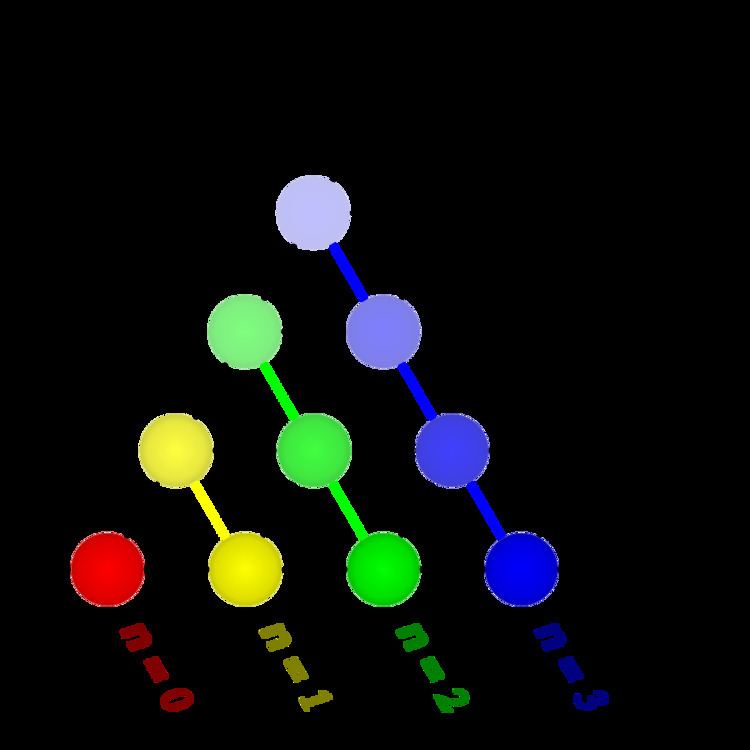 | ||
In mathematics, Pascal's simplex is a generalisation of Pascal's triangle into arbitrary number of dimensions, based on the multinomial theorem.
Contents
Generic Pascal's m-simplex
Let m (m > 0) be a number of terms of a polynomial and n (n ≥ 0) be a power the polynomial is raised to.
Let
Let
nth component
where
Example for ∧ 4 {displaystyle wedge ^{4}}
Pascal's 4-simplex (sequence A189225 in the OEIS), sliced along the k4. All points of the same color belong to the same n-th component, from red (for n = 0) to blue (for n = 3).
Pascal's 1-simplex
nth component
Arrangement of △ n 0
which equals 1 for all n.
Pascal's 2-simplex
nth component
Arrangement of △ n 1
Pascal's 3-simplex
nth component
Arrangement of △ n 2
Inheritance of components
From this follows, that the whole
Example
For more terms in the above array refer to (sequence A191358 in the OEIS)
Equality of sub-faces
Conversely,
From this follows, that for given n, all i-faces are numerically equal in nth components of all Pascal's (m > i)-simplices, or:
Example
The 3rd component (2-simplex) of Pascal's 3-simplex is bounded by 3 equal 1-faces (lines). Each 1-face (line) is bounded by 2 equal 0-faces (vertices):
2-simplex 1-faces of 2-simplex 0-faces of 1-face 1 3 3 1 1 . . . . . . 1 1 3 3 1 1 . . . . . . 1 3 6 3 3 . . . . 3 . . . 3 3 3 . . 3 . . 1 1 1 .Also, for all m and all n:
Number of coefficients
For the nth component ((m − 1)-simplex) of Pascal's m-simplex, the number of the coefficients of multinomial expansion it consists of is given by:
that is, either by a sum of the number of coefficients of an (n − 1)th component ((m − 1)-simplex) of Pascal's m-simplex with the number of coefficients of an nth component ((m − 2)-simplex) of Pascal's (m − 1)-simplex, or by a number of all possible partitions of an nth power among m exponents.
Example
Interestingly, the terms of this table comprise a Pascal triangle in the format of a symmetric Pascal matrix.
Symmetry
(An nth component ((m − 1)-simplex) of Pascal's m-simplex has the (m!)-fold spatial symmetry.)
Geometry
(Orthogonal axes k_1 ... k_m in m-dimensional space, vertices of component at n on each axe, the tip at [0,...,0] for n=0.)
Numeric construction
(Wrapped n-th power of a big number gives instantly the n-th component of a Pascal's simplex.)
where
